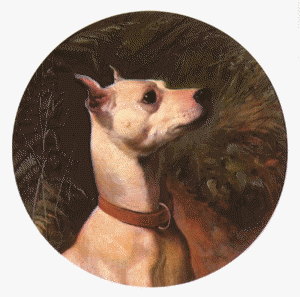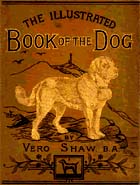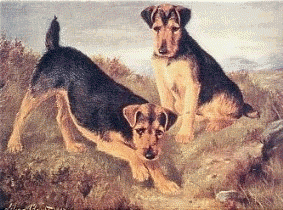| |
|
Extinct
& Non-Existent Terriers

English White Terrier" by George Earl
Many of the
terrier breeds that people now lament the
"extinction" of, never actually existed except
in the minds of Victorian picture book makers.
In The Welsh Terrier Leads the Way, Bardi
McLennan recounts the relatively recent origins of the
Welsh Terrier.
"In 1800 there were only 15 designated breeds of
dogs, and 50 years later there were only 50."
That is of ALL dogs, not just terriers. As late as 1850,
a lot of breeds were still not very distinct and several
breeds were known by different names. For example, in
1851, the Yorkshire Terrier was also known as "the
broken-haired scotch terrier." Only in 1870 was a
Yorkshire Terrier firmly designated as a breed and breed
name. Before then litter mates were often shown in
different breed categories -- a situation that occurred
with the first prize-winning Jack Russell, which had
previously won shows as a "white Lakeland."
The Welsh Terrier and Old English Black and Tan"
terriers were the same dog -- a type of rough-stock
Lakeland dog used in Wales and in the North. These dogs
had a fair amount of variation in terms of size and
shape, but generally had more color than the "white
foxing terriers" preferred in the South.
These rough-coated terriers existed without too much
conformity in name or shape (as they still do in the
working terrier community in the U.K.), but conformity
and a brand name were essential characteristics of Kennel
Club registration, and an intrepid history (however
fanciful) certainly did not hurt sales.
With the rise of dog shows in the 1860s, the race was on
to give every odd-looking dog a name and
"improve" them, and terriers were at the top of
the list.
One group of Kennel Club breeders decided to embrace a
rather ponderous name and an incredible assertion for the
brown and black dogs of the North: they were, they
asserted, "the root stock" of all terriers in
the British Isles, and that they were to be called the
"Old English Broken-Haired Black and Tan."
The assertion that these dogs were the root stock of all
terriers in the UK is rather laughable -- no one know
what the "root stock" was, and in any case
there probably was no single "tap root," but
instead a fine net of "rootlets" that spread
far and wide and included a lot of dogs that were not
terriers at all -- dachshunds, whippets, beagles, and lap
dogs, for example.
In any case, the Welsh
were somewhat outraged to have the English bring down a
few of "their" dogs and claim they were an
"Old English" anything. These were Welsh dogs,
and the Welshmen moved quickly to establish that fact.
The Welsh got organized quickly, and in 1884 they held
the first dog show with classes just for Welsh Terriers
in Pwllheli, North Wales with 90 dogs in attendance -- a
rather impressive opening shot in this little
"terrier war."
For their part, proponents of the "Old English Black
and Tan" moniker could not seem to coalesce into a
real club; in fact they could not even agree on a name
for their supposedly "Old English" breed. Some
called it the Old English Broken-Haired Black and Tan
Terrier, some the Old English Wire Haired Black and Tan,
some the Broken-Haired Black and Tan, and some just
"Black and Tan" -- a color-descriptive name
that had been used about as often as "white
dog" or "yellow hound".
Whatever they might have called the dogs, this new Kennel
Club "breed" was in fact a put-up job comprised
of a mix of terrier types and they had difficulty
breeding true.
In 1885 a survey of the winning dogs in the ring found
that all of them were, in fact, first generation dogs,
i.e. not Black and Tans out of Black and Tan sires and
dams, but Black and Tans produced out of crosses with
other breeds. For example, the winner of the first show
in 1884 was a dog named Crib that was a cross between a
blue-black rough terrier and a famous smooth fox terrier
owned by L.P.C. Ashley called Corinthian.

Vero Shaw's Book of the Dog |
In 1885, the Kennel Club
took a Solomonic approach to the name and breed standard
for the dog, featuring both dogs at their 1885 show. On
April 5, 1887, however, because the English could not get
organized, they were dropped from Kennel Club listings,
and the new "Welsh Terrier" breed was born,
perhaps propelled forward in popularity a bit by the rise
of David Lloyd George, the son of a Welsh cobbler, who
himself has risen from humble origins to stand
should-to-shoulder with the gentry.
The "Black and Tan" terrier is not the only
breed that either never existed (or still exists today,
depending on how you look at it). At the same time that
one faction was pushing for the introduction of the
"Old English Black and Tan Terrier" another
faction was pushing for the introduction of the
"English White" terrier. In fact this dog was
nothing more than a "pet-quality" smooth-coated
Jack Russell terrier, indistinguishable from the white
foxing terrier except that it was less well bred and
might have seen a bit of toy lap dog introduced into the
gene pool. It was not a breed that caught on.
Both the "Black and
Tan" terrier and the "English White"
terrier live on in the fevered minds of the
breed-obsessed thanks to a book by Vero Shaw entitled
"The Illustrated Book of the Dog."
Printed in 1881, right in the middle of the "terrier
wars," this book contains about 100
chromo-lithograph plates and engravings of dog breeds
that were being put forth as distinct entities at that
time. Shaw rather optimistically included the "Black
and Tan" as well as the "English White,"
betting that the political machinations of English Kennel
Club dog breeders would prevail.
He was wrong, which is how two "ancient" breeds
of terriers, that in fact never exited, managed to appear
on the scene for less than 20 years and then disappear
altogether.

|
|

